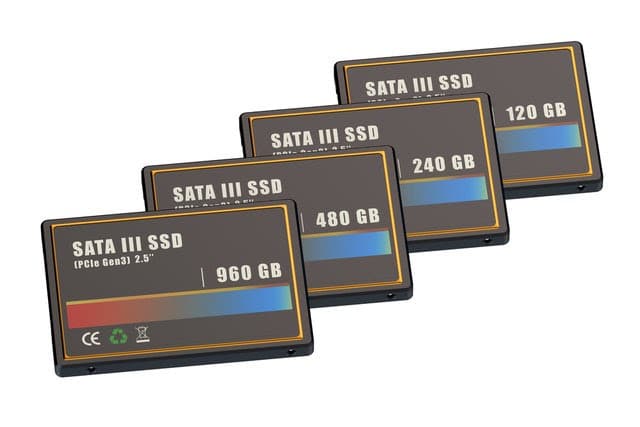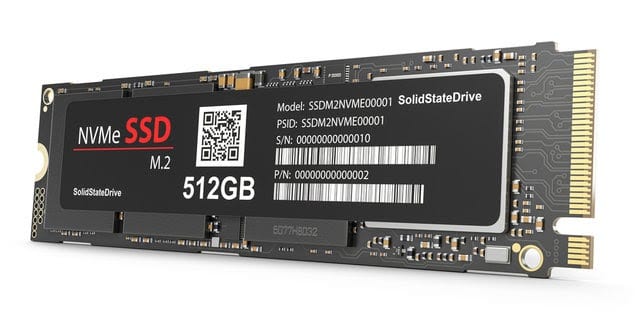Finding the perfect storage solution is not always easy, as you need to select from various available options. Initially, it is to select between SSD (Solid State Drives) and HDD (Hard Disk Drive), and later it is to opt for best from different SSD and HDD. Well, when it comes to PCIe SSD vs SATA, there are many if’s and but’s.
Both the SSD have their own advantages based on the usage. You need to opt for the one that fits your needs. Let’s see what an SSD is first and then move on to PCIe SSD and SATA. Understanding the technology individually makes it easy to know the difference between them later.
What is SSD?
SSD (Solid State Drives) is the secondary storage drive in computer storage. They are faster, more reliable, and use less power when compared to HDD. These drives have a higher transfer rate and lower latency. Computers with Solid State Drives are more efficient – they boot up faster, they are able to launch applications and programs faster, and are generally smoother than computers with HDDs. In recent years, SSDs have become more affordable and widespread.
Now, this explanation makes your storage solution search easy when it comes to HDD vs SSD. However, the main debate is between PCIe vs SATA. As both of these come under SSD, selecting one can be confusing.
What is a SATA SSD?

SATA or Serial Advanced Technology Attachment is the name of the connection interface used by the SSD to communicate with your computer. The SATA interface was created in 2003 and is one of the most-used connection interfaces today. When you buy a SATA SSD, you can rest assured that there will be no hardware incompatibility, and it will work with whatever laptop or desktop you own, even if it is an old computer.
A SATA SSD looks exactly like a standard hard drive, a 2.5-inch form factor, the size of a regular laptops’ hard drive. It connects to the motherboard of the computer via a SATA cable. SATA SSD is the most affordable among the various SSD form factors and is seen most commonly in laptops and desktop PCs.
The latest SATA SSDs use SATA 3.0, which has a maximum transfer speed of 6Gb/s. However, this speed is only theoretical, and in real-world tests, it was seen that even the fastest SATA SSDs peak at about 4.8Gb/s due to physical overhead during the encoding of data while transferring.
What is a PCIe SSD?

PCIe (Peripheral Component Interconnect Express) is used to connect different peripherals to your computer, which includes graphic cards and SSDs. Out of various PCIe versions available, you can connect SSDs to PCIe 3.0. However, the latest version of PCIe is PCIe 4.0, which is supported by some SSDs.
PCIe has different slots, and each slot has a different bandwidth. The total bandwidth offered by PCIe 3.0 x16 is 16 GB/s. Here, x16 is the PCI interface. The other interfaces include x1, x2, x4, and x8. Each interface has different sizes. The transfer speed in PCIe 3 for x2 is 2 GB/s, x4 is 4GB/s and x8 is 8 GB/s.
Well, you can get a good speed and performance when PCIe is used with the M.2 SSD. Now, the basic understanding of both SSDs are clear; we can have a good comparison between both based on different factors.
PCIe SSD Vs SATA: The Key Differences
These are several key differences between these storage devices. Some of the factors for PCIe SSD vs SATA are –
Connection:
SATA devices use SATA cables to connect to the motherboard. If you wish to connect more drives, then SATA is a better option. PCIe based SSDs plug directly into a slot on your motherboard. The motherboards don’t have more PCIe slots; hence it is not a better option if you wish to connect multiple SSDs.
Performance:
As mentioned earlier, there is a great disparity between the data transfer speeds of the two SSDs. SATA 3.0 maxes out at 6Gb/s, whereas just two lanes of PCIe 3.0 can perform three times better than a SATA 3.0 based SSD at almost 2000 MB/s.
Price:
SATA SSDs are more affordable, and with the immense popularity of the SATA interface, the prices are coming down every day. PCIe SSDs, on the other hand, are still quite expensive, sometimes the costing is as much as a new computer itself.
Size:
As mentioned earlier, PCIe SSDS fits on the motherboard, taking the least space compared to SATA. So, if you are using a mini PC and have limited space, then a PCIe SSD is a better option. SATA SSDs can take up space for cables as well.
Storage Capacity:
SATA SSD has more storage capacity than PCIe SSD. The capacity of SATA SSD is around 4 to 6TB, whereas, in the case of PCIe it is just 2TB.
Well, the uses of both the SSDs will give you a better understanding of them in real-world scenarios.
PCIe SSD uses
- Typically used where the read and write operations need to be performed in ten microseconds
- Data warehousing
- Machine learning
- Processes which require fast throughput and low latency
SATA SSD uses
- On most of the PCs and laptops where high performance is not required
- Companies who don’t need faster data processing
PCIe SSD vs SATA – Difference in tabular form
The table below explains the difference between PCIe SSD and SATA in short. This can help you decide on one SSD quickly and easily.
| Comparison Factor | PCIe SSD | SATA |
| Connection | To be mounted on the motherboard | Needs SATA cables for connection |
| Performance | Better than SATA (16 GB/s transfer speed) | Not as good as PCIe SSD (6Gb/s transfer speed) |
| Price | High | Low |
| Capacity | 2TB max | 4 TB to 6 TB |
| Ideal use | High processing speed application like data warehousing and machine learning | Low processing speed. Mostly for daily use where fewer data processing is involved |
Note: SATA transfer speed is measured in Gigabits (Gb) per second and PCIe speed is measured in GigaByte (GB) per second.
PCIe SSD Vs SATA – Which one to go for?
SATA and PCIe are both better than any other HDD. Well, the choice between two clearly depends on your needs, use, and price. When it comes to personal use, SATA SSD is always a better choice. SATA SSDs are better when it comes to pricing and performance is well suited for personal use, where more data processing is not required.
While PCIe SSDs are amazing to have, the truth is that you will not probably utilize its power and capabilities in your daily computing life. Unless you have huge amounts of data to process, you are better off without a PCIe SSD.
If you are the one who needs low latency, high throughput, and has no issues with cost, then you can opt for a PCIe SSD without any second thoughts. The organizations that need to process online transactions or data within 10 microseconds should opt for a powerful PCIe SSD.
Again if you need multiple SSDs, then you need SATA as devices have multiple slots for connection. The PC, which needs more storage space to store raw files, needs SATA. On the other hand, if storage capacity is not your concern, then PCIe 3.0 and PCIe 4.0 SSD is a better option, as it takes less space on your device. Hence an optimal solution for compact size devices.
If you are thinking of an m2 SSD, then it goes well along with both PCIe and SATA. However, to have better performance and speed, it is best to use it with PCIe.
Conclusion
With the detailed explanation given above, selecting one SSD can now be easy for you. The selection of storage solutions always depends on the intended use. All the SSDs are best when it comes to performing as per intended use. The details discussed above with regard to PCIe SSD vs SATA gives you a clear explanation based on various factors.
You can also check out the use of each SSDs to get a clear understanding of the real-world application. If you opt for PCIe, then you can choose between PCIe 4 and 3.
Also, check:
- Top Solutions To Fix 100% Disk Usage Issue In Windows 10
- Effective Tips To Speed Up Windows 10 and Boost Its Performance
- Common Reasons Why Chrome Keeps Crashing and All Possible Fixes
